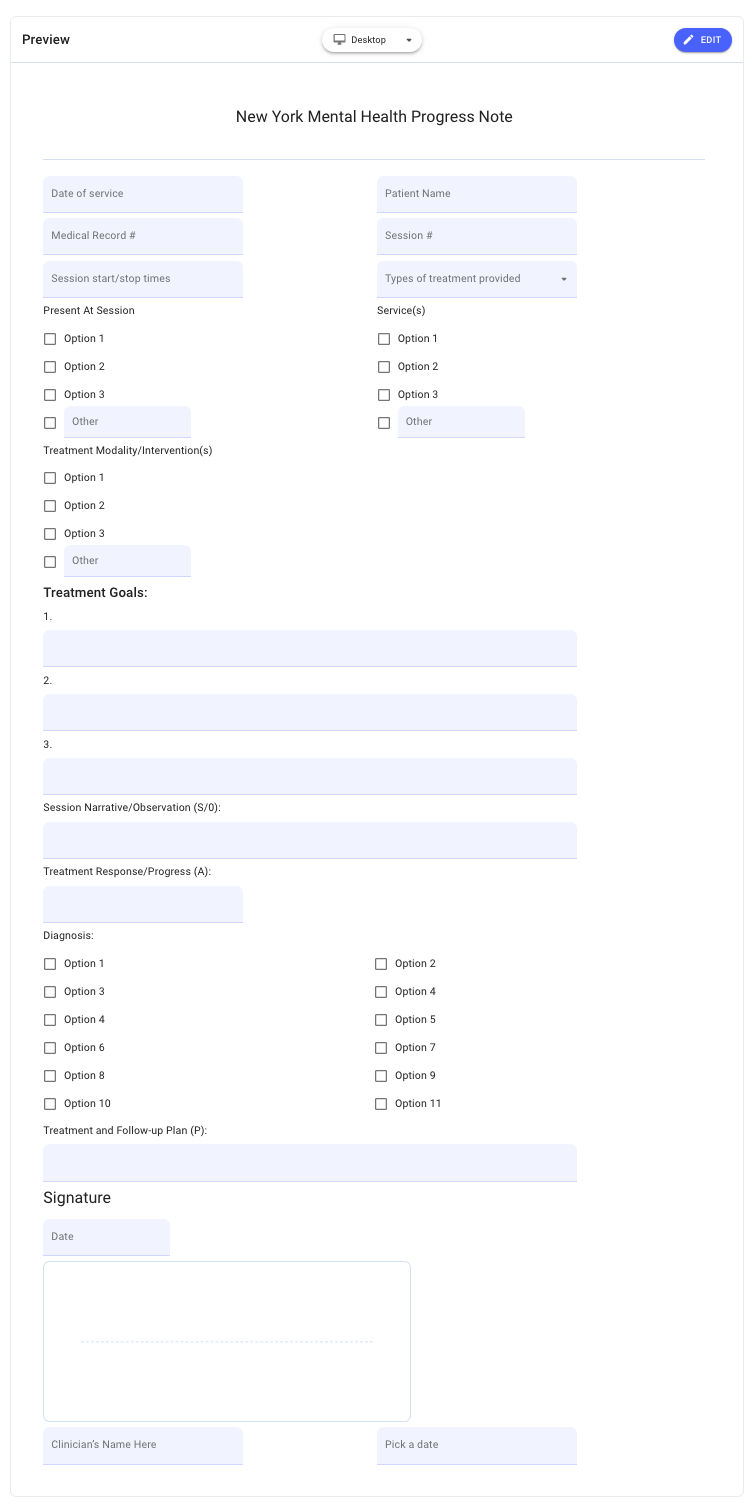Are you struggling to keep up with clinical documentation? Wondering how to write progress notes faster (or any therapy note for that matter)?
If so, you’re not alone.
Therapy notes are arguably one of the most dreaded aspects of any therapist’s job. They’re monotonous and time-consuming.
So many therapists put them off until they’ve accumulated hours’ worth of note-taking, making the process even more dreadful.
In this blog post, we’ll discuss how to write faster therapy notes. This will also include how to write psychotherapy notes faster so you can make therapy note-taking much less stressful.
Get Yocale’s Custom-Progress Notes Builder Now
What Should Be Included in Progress Notes?
When it comes to how to write progress notes faster, one of the reasons why many therapists struggle is that they lose sight of their primary purpose.
Unlike psychotherapy notes (also known as process notes, private notes or session notes), progress notes are merely meant to serve as an official record that each therapy session has occurred. They’re also meant to be shared with other mental health professionals to ensure continuity of care as well as for insurance purposes.
Generally speaking, they’re not made to serve as a memory aid (except for homework sections) and therefore do not need to be narratives. More importantly, they’re also legal documents and form part of a patient’s medical record. They can be also subpoenaed in some legal situations, as well as accessible to patients themselves; as such, the general rule is that progress notes should not include anything you don’t want to be read aloud in a courtroom.
In short, progress notes should be brief in order to not only protect clients, both from a legal and a relationship perspective. At the same time, they should provide enough detail so that the notes are actually useful to other treatment providers. The goal here is to ensure that you want someone completely unfamiliar with the case to see how you’ve made the conclusions you have.
Generally speaking, progress notes describe treatment modality, goals, responses and a follow-up plan. However, keep in mind that some states have particular requirements for what goes into your progress notes. Your work setting may also have its own requirements.
A progress note should look something like the below:

However, the important thing to note is unless your organization specifies a very specific format, you have the flexibility to add additional items to certain sections. For instance, this might include resources, homework or whatever else you find helpful.
How Long Should Progress Notes Take to Write?
For the sake of your sanity, progress notes should take no longer than five to ten minutes at most. If you’re in an agency setting, this is typically the expectation. And in the name of work-life balance, you cannot afford to spend any longer than this anyway!
How to Be Detailed Enough Without Being Too Vague: How to Write a Good Note
While notes should be vague, therapists also need to strike a balance between generality and being clinically useful.
A good rule of thumb is to consider whether you and your treatment team can understand what happened in a session but a random person wouldn’t.
How Do You Write Progress Notes Faster?
So, how can therapists write progress notes faster? Here are some tips:
1. Follow a Standard Format (SOAP Notes, Etc.) or Create Your Own
The benefit of following a standard format (SOAP, BIP, etc.) is that it reduces the mental fatigue needed to actually write the note. In fact, this is often why notes can be so time-consuming; without a template to follow, your brain has to work so much harder!
Have you ever heard that many successful people decide to wear the same thing every day? The reason is that it reduces the number of decisions they need to make every day.
Other templates that therapists like include DAP, PIRP, STEP or BIRP.
And once again, you may also have the flexibility to slightly customize your progress notes as well to include anything else that you may feel is necessary and that works with your own personal brain.
2. Include Checkboxes and Dropdown Lists
If you have the flexibility to create your own progress note template, you can customize it to include more checkboxes, dropdown lists and other similar features. This allows you to still convey the necessary information while reducing actual writing space.
3. Cut and Paste
Another tip to write faster progress notes is to cut and paste things from a pre-set list, such as a list of interventions. With Yocale, you don’t even need to copy and paste. Instead, you can simply “favorite” your pre-defined text (i.e. your list of interventions) and click to insert it into your notes.
Again, this reduces the mental bandwidth needed to actually write the note. At the same time, you can still customize the wording (which will be particularly necessary for Medicaid audits).
4. Consider Collaborative/ Concurrent Documentation
In recent years, there has been a shift toward collaborative (or concurrent) documentation.
Collaborative documentation is the act of writing your progress notes alongside your patient.
There are several benefits including the fact that it reduces note-taking time. However, a 2018 study published in The Journal of Human Services: Training, Research and Practice also found that this style of documentation also results in a stronger therapeutic alliance. It also results in shared decision-making for treatment options and even greater accuracy in documentation.
Some therapists’ clients actually really like it as it provides a focus period at the end of the session and an opportunity to review future plans. It can also serve as a reminder for therapists to circle back to things they wanted to follow up on but hadn’t had a chance to yet.
In this method, it can be helpful to use shorthand for interventions and then simply copy and paste from a document that contains your list of interventions. This eliminates the need to think about phrasing. (Or, if you’re using Yocale, you can simply select text from your “Favorites” list).
You can also combine this documentation process with mental health practice management or EHR software, which means you can type your notes directly into the software. Your notes are then uploaded into the client’s profile and stored securely in the cloud. (Some therapists prefer to take handwritten notes via a stylus and tablet).
Read why more therapists are moving to electronic therapy notes here. EHR software is not yet mandatory by any psychological association, but it can definitely make your life easier. You’ll also be able to automate scheduling and appointment booking with online booking.
Some therapists then like to start most sessions by reviewing their previous notes, finding that it provides continuity. It also gives an opportunity for patients to correct anything. In this way, it can be a good way to build rapport with your clients.
Get Yocale’s EHR for Mental Health Professionals Now
5. Think About Voice Dictation
Many therapists find a lot of success with voice dictation. Instead of typing their notes after their session, they simply dictate them instead.
6. Reserve Time at the End of Each Session for Note Taking – And Make it a Routine!
In many agency/community-based settings, note-taking is done ten minutes or so before the end of each session. While this doesn’t necessarily make note-taking faster, it can shave an hour or so off the end of your day.
If you struggle with procrastination, and you don’t have such a process in place already, it can be a good idea to get into the habit of reserving ten minutes at the end of every session for note writing. The idea here is that note-taking is taken care of on a daily basis before it has a chance to accumulate and become too much of a chore.
7. Make it a Positive Experience
Writing therapy notes is an inevitable part of being a therapist, so it’s best to make the process as pleasant as possible.
Consider creating a calming ritual for yourself such as making a cup of tea, turning on your favorite music or lighting a candle.
Over time, these little rituals will act as cues and will serve to get you into the writing process without much thought.
Therapist-Recommended Resources for Writing Progress Notes
The following resources come recommended from other therapists:
How Do You Write a Good Psychotherapy Note?
At the end of the day, a good psychotherapy note (also known as session, process or private notes) is one that fulfills its purpose.
The purpose of a good psychotherapy note is ultimately to help form the basis of a patient’s treatment, but many therapists tend to get lost in the details of things that don’t always contribute to the patient’s treatment.
It’s important to note that while psychotherapy notes receive special protection under the HIPAA privacy rule, a court order can still specifically request these notes.
That’s why they should still be somewhat vague while still containing enough information to be clinically useful.
An added benefit of having briefer notes is that you’ll have less to review prior to your next session.
What Should a Psychotherapy Note Include?
Psychotherapy notes, which are optional, do not need to follow a specific format but are somewhat more detailed than progress notes.
At the end of the day, though, psychotherapy notes should include anything that helps you serve your patients better. For instance, this might include:
- Observations or hypotheses
- Questions
- Feelings relating to the session
- Quotes
Psychotherapy notes do not include medication information, diagnosis or treatment plans.
How to Write Psychotherapy Notes Faster
Some of the tips above about writing faster progress notes will also apply to psychotherapy notes. However, there are some other tips that particularly apply to psychotherapy notes.
- Remain Objective
While psychotherapy notes contain more observations, it’s still easy to find yourself getting bogged down by trying to validate your client’s feelings.
While this makes sense and is understandable, reporting on the behavior is often much simpler and less time-consuming.
- Follow a Formula
Much like you might follow the SOAP format for writing progress notes, following a formula (or even using a template) can also be helpful for writing psychotherapy notes. Again, it reduces the mental effort required to think about what to write.
It will also help ensure you don’t miss any key points.
- Use Shorthand
Using shorthand can also be helpful for writing faster notes. Here are some examples:
- CT = client
- BX = behavior
- TX = treatment
- Consider Writing Notes During Your Session
While many therapists prefer not to write notes during their sessions, some definitely do as it cuts down their total amount of therapy note-taking time.
The key here, though, is to maintain eye contact.
As mentioned above, you can also use more discrete types of technology like a stylus and a tablet. The notes are automatically saved in the client profile and securely stored in the cloud.
How Are Psychotherapy Notes Organized?
More and more mental health practices are moving to a paperless practice. They’re replacing their paper-based documents with digital files and storing them in HIPAA-compliant, cloud-based EHR software.
There are many reasons for this shift, including the fact that electronic records save a lot of time. They’re also more organized, secure and environmentally friendly. You can read about the benefits of electronic therapy notes and a paperless practice.
Wrapping it Up
Therapy notes are an inevitable part of every therapist’s job. But the good news is that with a little fine-tuning and establishing a structure and positive routines, you’ll learn how to write progress notes faster (and how to write psychotherapy notes faster) in no time.
Book a demo to learn more about Yocale progress notes, or subscribe to our newsletter for more tips and tricks for therapists like you!
Sources:
https://www.apadivisions.org/division-31/publications/records/progress
https://scholarworks.sfasu.edu/jhstrp/vol3/iss1/2/




